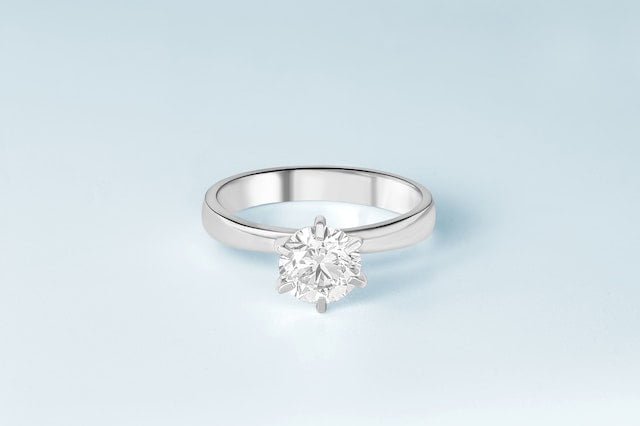Round diamonds are the most popular cut because they maximize a diamond’s fire and sparkle. This means they’re the most sought-after shape for engagement rings.
However, you should know a few things before shopping for one of these stones. Here are some of them:
Clarity
Clarity is one of the most important things to consider when buying a round white diamond ring. It can distinguish between an amazing eye-clean stone and a cloudy, less beautiful stone.
While it’s rare to find a flawless diamond, it’s much more common for stones to have imperfections, which can be described as “inclusions.” The GIA clarity grading chart goes from FL (flawless) and IF (internally flawless) to VVS1 and VVS2 (tiny inclusions that are practically invisible to the naked eye), then SI1 and SI2 (slightly included), then I1, 2, and 3 (included, very-visible flaws).
For a diamond to have a high clarity grade, it must have no inclusions or blemishes visible to the unaided eye. The GIA’s clarity rating system is so strict that only about 1% of all diamonds ever found have no imperfections, and it’s also important to note that FL and IF diamonds lose their flawless grade when they are set in jewelry.
The clarity of a diamond can be affected by the shape, size, and weight of the stone and its color. For example, emerald and Asscher cuts do not hide inclusions as easily as brilliant-cut diamonds. This means that the inclusions in these diamonds are more noticeable than those with a similar carat weight and clarity grade.
Color
One of the most important factors when buying diamonds is color. White diamonds are the most desired, but yellow ones can also be attractive.
In a ring setting, the color of your diamond can significantly impact how the rest of your jewelry looks. You don’t want the center diamond to appear too dark or light, especially if your ring has accent diamonds with higher color grades.
There are several ways to hide color in your ring, but the most effective way is to choose a near-colorless round diamond. This means a diamond with a color grade of J or lower.
A high-color diamond can make the rest of your ring seem two-toned, which you don’t want to see in an engagement ring.
You can get around this by choosing a setting that doesn’t expose the color of your diamond as much. This could mean using a white gold or platinum band instead of yellow or rose gold and opting for a solitaire or halo-style setting.
The third C is clarity, which determines the number of flaws in a diamond. These flaws, or ‘inclusions,’ are tiny impurities formed when the stone was created. While these flaws aren’t visible to the naked eye, they can be noticeable through the magnifying glass that gemologists use.
Carat
Carat weight is one of the 4 Cs of diamonds, and it’s essential to know how it affects a ring’s price. Generally speaking, a larger diamond is more valuable than a smaller one, but this doesn’t mean you should prioritize the carat size over other aspects of the diamond.
The stone’s proportions and facets determine a diamond’s carat weight. This means that two one-carat diamonds can appear different in size depending on the stone’s depth, table, and cut.
A round white diamond ring is the most popular shape because they have ideal proportions and are the best way to create an elegant ring. However, other conditions can also be attractive when set in a circle.
When looking for a round white diamond ring, it’s worth checking the carat weight to see how much sparkle the diamond will bring to your ring setting. While 1 carat is the most common, there are many sizes available that are incredibly sparkly and beautiful.
For example, a half-carat diamond can be much more budget-friendly than a one-carat gem! In addition, half-carat diamonds tend to be much more sparkly than a total carat.
When choosing a round white diamond ring, check the carat weight, clarity, color, and cut. You want to avoid getting a large diamond with alarming clarity and color or a small diamond with a poor amount.
Setting
The setting of your round white diamond ring is one of the essential elements to consider. The correct setting will enhance the beauty and fire of your diamond and help it sparkle like a star. However, choosing the right location for your ring will also depend on your style and preferences.
There are several styles to choose from when selecting the right setting for your round white diamond ring. These styles range from traditional prong settings to contemporary bezel and channel settings.
Prong settings feature slim metal arms that cradle the center stone at the girdle, holding it in place while allowing light to enter and exit from all angles. This setting is popular with many diamond shapes and is especially well-suited to larger stones.
Pave settings are another popular style and cover areas of the ring band in many tiny diamonds. This gives a ring an incredible effect and makes the diamonds appear to shimmer continuously, making it an attractive option for any diamond shape.
Bar settings are similar to the channel setting but enclose the diamond on two sides, with metal bars holding the other two sides in place. This is a common choice for brides who want to add extra detail to their engagement ring without sacrificing the look of the center stone.




